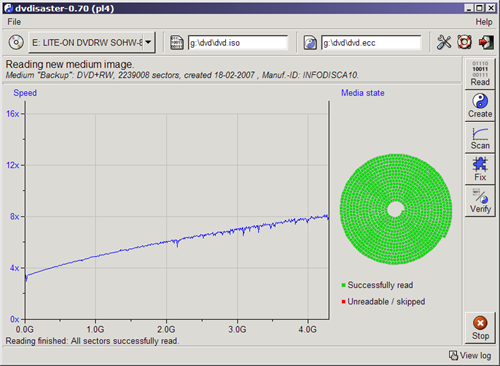Storing data on optical discs might be the cheapest and easiest means of data backup, but it suffers from one major flaw – burned DVDs degrade with time. I’m not talking about scratches, which can be avoided with careful handling, but the degradation of the write media itself.
dvdisaster is a software that helps you protect your data by including certain error detection and correction codes along with the burned data, that enables the software to recover the data from the disk even if the disk develops errors – either through scratches or errors because of age. The software takes any ISO image and generates an error correction file for the image, which can be burnt to the DVD along with the image or stored separately on other media. The error correction file takes about 15% the size of the ISO by default. So if the ISO image is a 4.7GB DVD, the error correction file itself will be about 700 MB.
When the disk develops errors or is scratched and you need to recover the data from it, dvdisaster uses this error correction file to correctly recover the original data.
To protect any DVD or CD, the user first needs to create an image of the optical disc which can be done using dvdisaster. Next, one needs to create the Parity file or error correction file (.ECC). It’s recommended to store the parity file separately and not on the media, to prevent corruption of the error correction file itself.
When you need to recover the data, launch dvdisaster again and create another image file of the damaged media. Then select the .ECC file for that disc and click on Fix.
dvdisaster can also be used to recover the contents of a damaged disc even when no ECC data is available. dvdisaster first creates an image of the entire disc skipping damaged parts, and then attempts to recover the missing parts by repeatedly rescan.
dvdisaster is free and is available for Windows, Linux, FreeBSD and Mac OS X.


Take a look to ICE ECC http://www.ice-graphics.com/ICEECC/HistoryE.html. It is a more general application and far more configurable.
ReplyDeleteTo gmag11: you can't compare the two, because ICE ECC is file based data recovery, while Dvdisaster is image based recovery, which is way more powerful. If a disc is damaged and you can't read the folder content, then ICE ECC will not be able to recover your files, while Dvdisaster on the other hand can. ICE ECC can ONLY recover data from a file when the file is available.
ReplyDelete